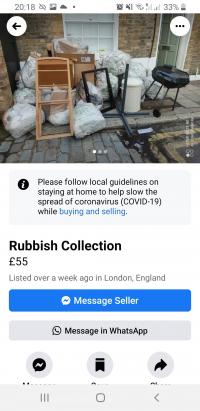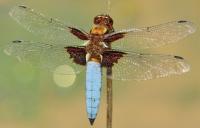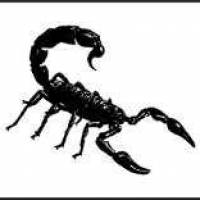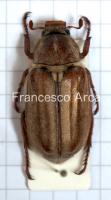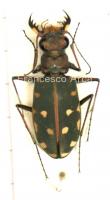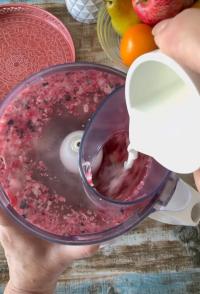Collecting insects (part 2)

PINNING, MOUNTING AND DISPLAYING INSECTS
Temporary Storage Boxes
You will need a least one, but more likely two “Schmidt Boxes”, a specially designed and constructed container for long term insect storage. The lid is tightly fitted to the box to help prevent entry of scavenger insects which feed on dead insect specimens, into the box. Cigar boxes make excellent containers for temporary storage of pinned insect specimens. Line the bottom of cigar boxes with styrofoam material, corkboard, balsa or cardboard to receive and hold the insect pins. While cigar boxes are fine for temporary storage, they are poor over long periods of time. For extended storage and for display, tighter containers are essential. Add naphthalene crystals, placing them into a small container in one corner of each display box to prevent damage to your specimens.
Insect Pins
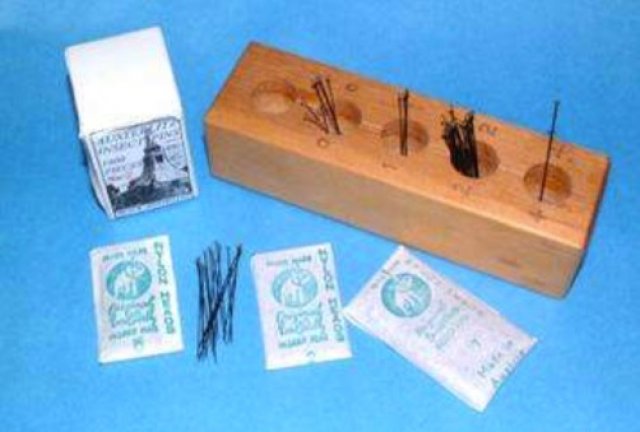
Special pins are needed to pin insects. They come in several sizes from 00 through 7, the size of the pin increasing with each number. Number 3 insect pins are the best for most purposes. Insect pins are purchased from biological supply houses and can be found in some hobby stores. Never use common pins.
Pin Storage Rack
A 4-inch long section of 2" x 4" lumber with 6 one-half inch diameter drilled holes, each 3/4" deep, makes a handy pin storage rack.
Pinning Block
Larger insects should be mounted using a wooden pinning block, a simple piece of equipment. A very small hole is bored almost through the bottom in the middle of each step. A simpler pinning block can be made by drilling three holes—1, 3/4, and 1/2 inch deep—into a small wooden block. Proper use of a pinning block will result in an attractive collection with the insect, collection and identification labels in uniform position. Note the dimensions of a pinning block in the drawing below.
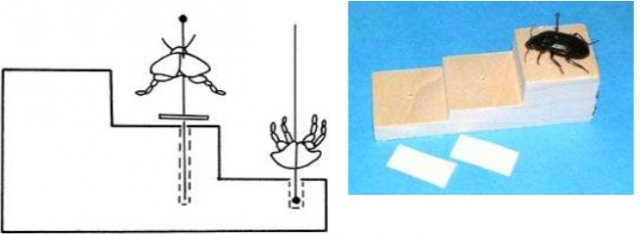
Spreading Board
Mounting butterflies and moths is a special technique that requires a spreading board to do an attractive job. The spreading board is usually made of soft pine with a piece of balsa or cork underneath the center groove to receive insect pins. An acceptable spreading board can be made from balsa wood or cardboard strips, 2 heavy paper clasps, four corks and four common pins. Spreading boards can also be ordered from biological supply houses and hobby stores.
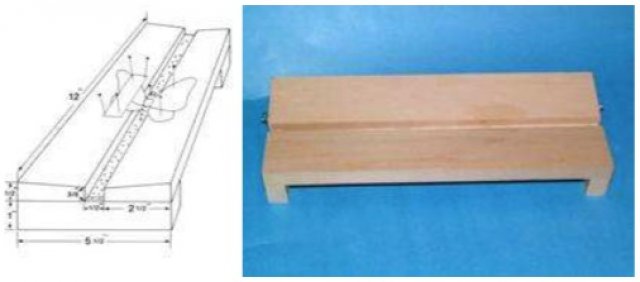
Pinning Insects
When working with your collection, be sure to follow these instructions precisely and routinely. Improperly pinned insects in your collection will be discounted. The rationale and main goal in developing and using proper procedures in pinning insects is to effectively expose and display critical details of insect structure -- the taxonomic characters which are used by insect classification experts (taxonomists) to key and identify insects.
The proper way to pin an insect depends on the type of insect that you have collected. Remember that soft-bodied insects such as caterpillars, mayflies, silverfish and some others cannot be pinned. The following diagram illustrates the proper way to pin various orders of insects. Note that the pin is usually just slightly to the right of the midline of the insect. Specimens should also be level and squarely mounted on the pin as shown. The use of a pinning block will help in obtaining proper height and positioning.
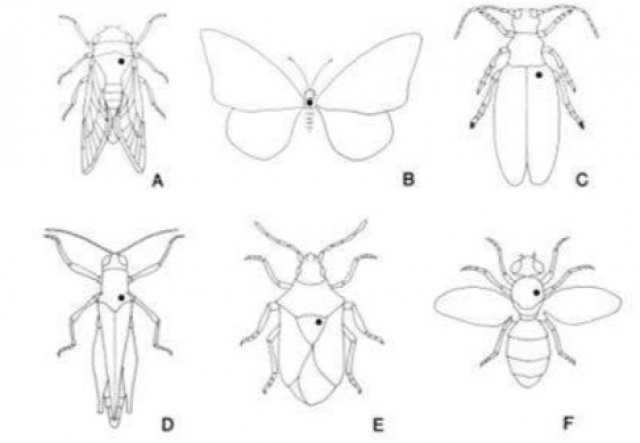
First, place the pin in the insect thorax in the proper position on the top step of the pinning block, pushing it in so that the top of the insect is quite close to the pin head. Then, remove the pin from the top step, reverse it and place the head of the pin in the lowest step of the pinning block. Push it down as far as it will go. This will result in positioning each insect about one-fourth inch from the pin head. The middle step on the block is to position the collection label. The lowest step is used to position the insect identification label.

Very small insects (less than 3/16 inch) should either be pinned with minuten nadeln (German for “tiny needles”), or glued on their right sides to tiny paper triangles. The latter procedure is called pointing. When pointing, first push a regular insect pin (No. 2 or 3) through the butt end of the triangle. Level the triangle by pushing the pin through the hole in the highest step of your pinning block. Bend the tip of the paper triangle slightly downward with a forceps and touch it to a tiny drop of glue or clear fingernail polish. Pick up the small insect carefully with forceps and mount it by touching it on its thorax (right side) to the drop of glue. Adjust the insect so that it remains squarely in position, then allow the glue to dry.
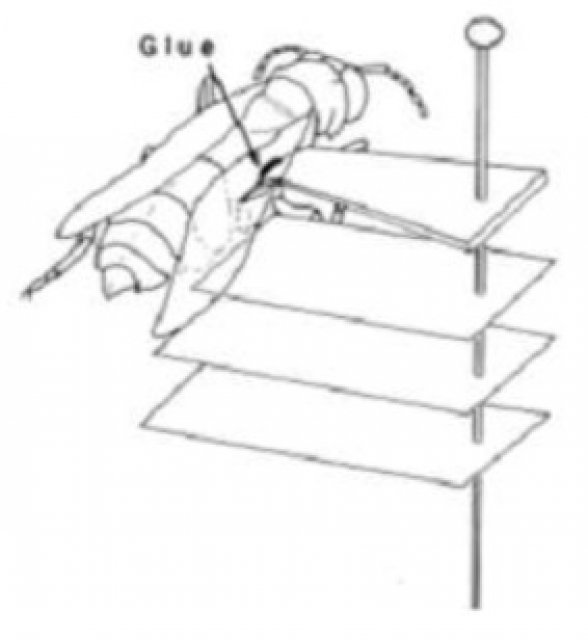
When using minuten, be very careful because they stick to the fingers and can easily be transferred to the mouth, nose or eyes simply by rubbing. The figure below indicates how minuten are used and the final position of the insect specimen.
Pinning and Spreading Butterflies and Moths
These insects must be done correctly or else their appearance will detract from the overall quality of your collection. This is an area where many beginning entomology students get off on the wrong foot, because they collect the insects, but don’t get them pinned right away. In some cases it may be
necessary to store them temporarily until they can be pinned.
Insects with large wings, such as butterflies, moths and dragonflies, can be temporarily stored and dried in paper triangles until you have time to relax, pin and spread them. rite the collection data on the outside of the triangle so that you have when you are ready to mount and label the specimen. Then place the freshly collected, pinched and killed insect inside the triangle with the wings held together above the body. Store them like files in an insect storage box with a tight fitting lid and add naphthalene crystals if the specimens will be stored for an extended period. Working with fresh specimens is much easier. Before trying to pin them, the specimens must be relaxed, as described earlier.
When pinning and spreading a butterfly or moth, before you begin to work, cut several thin strips of paper about 1/4" wide and 8"-10" long. Once these are ready, pick up the insect by the thorax and carefully push a pin through the middle of the thorax. Adjust the position of the butterfly on the pin and make sure that it is level, both on the sides and in both front and back. Place the pin into the hole in the tallest step of the pinning block, being careful not to damage the fragile wings. Adjust the width of the groove in the spreading board to be just slightly wider than the body of the butterfly. Remove the pinned insect from the pinning block and push the pin into the slot of your spreading board until the bases of the wings are just level with the top of the two side pieces. On some spreading boards this may require the use of a pin pliers, a tool that allows you to place pressure on the lower part of the pin, so that it will more easily penetrate the cork or balsa wood strip. With the fingers this is difficult or in some cases not possible.
Slip a paper strip between the wings (if they are upright) and use it to force the wings on one side down into position. Pin the ends of the paper down to hold the wings loosely in place. Do the same with the wings on the other side, also pinning the ends of the paper down.
Now take another insect pin or needle and slip the point through the leading edge of the right forewing (there is a strong vein just at the front edge of each wing) near its attachment to the thorax. Be careful not to tear the wing. Loosen the forward end of the paper strip and gradually bring the forewing up into final position. Pin the wing down with a paper strip. Repeat this procedure with the forewing on the other side. Using the same technique bring both hindwings into proper position and fasten all four wings firmly with the paper strips.
Note carefully that the rear edge of the two forewings should make a perfectly straight line across the back. The hindwings should be pinned so that the rear edge is held just slightly away from the abdomen. Position antennae with pins and if the abdomen has drooped, prop it up with pins so that it dries in a natural position.
Allow specimens to dry for several days before you remove the pins. Drying “freezes” the wing muscles of the insect in position. Rushing the drying process somewhat by placing specimens in an oven at 125EF. for about an hour will work, but may result in the wingtips curling upward and spoiling the insect's appearance. Be very careful if you attempt this. Using wider (3/4 inch) paper strips to hold the wings down will help to prevent distortion. Please see the illustrations below and movie clips for further detail on pinning lepidopterans.
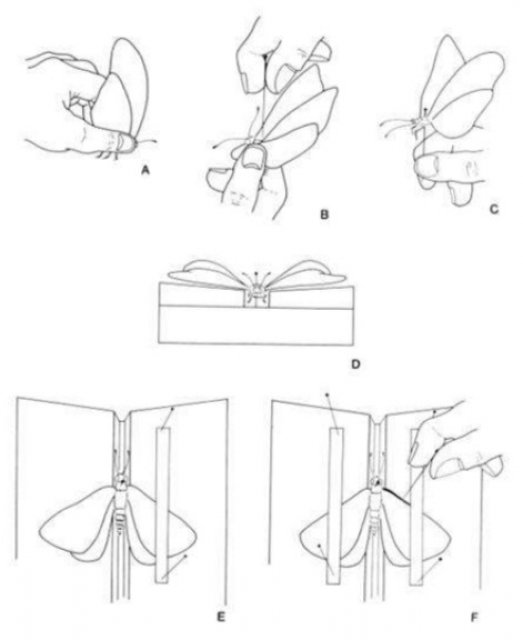
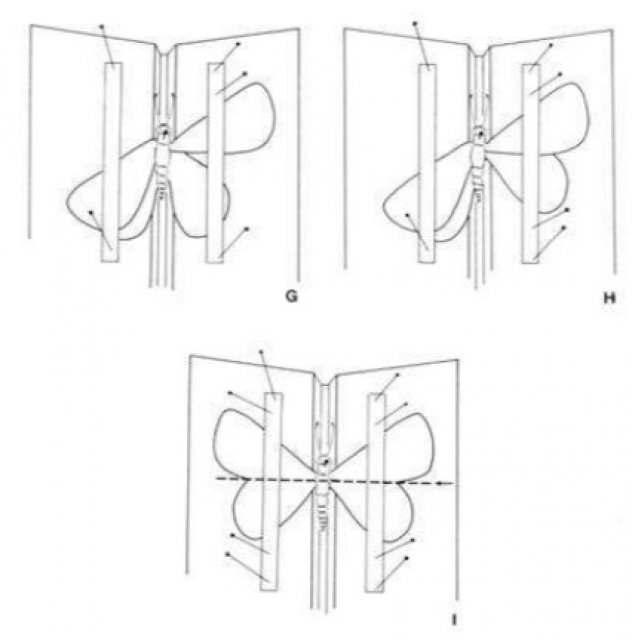
Large-bodied moths like Cecropia should be cut open on the underside of the abdomen and the contents removed with a cotton swab. The body cavity should be filled with cotton so that the specimen looks natural from above. If this is not done, the fatty material in the abdomen will decompose, releasing oils which may discolor
and ruin the specimen.
Labeling Insects
A collection has little value unless each insect is properly and accurately labeled. Labeling must be done as soon as possible after collecting, pinning and mounting or vital information may be lost. Note that many insects in museums today stand as living documents of biological diversity. Their precise collection locations, habitats, and data on plants on which they were found is important documentation. Many of these habitats have been or are being altered and in some cases destroyed. Many plant and animal species, once common and together in biological ecosystems, are now endangered or in some cases are already gone. It is essential that the presence of insects, plants and other creatures be documented for future generations.
Make your labels with your computer and print them off. Trim labels with a sharp paper cutter so the edges make nice, clean, and flat rectangles. Two labels should be placed on the pin below each insect specimen. Both labels should be of the same size and lined up parallel to the length of the body of the insect (not cross-wise). The insect head should be at the left and the label should read from left to right. However, in the case of "pointed" specimens, the labels should be parallel to the length of the point. The top label should have the county and state in which the insect was collected, the collection date and the name of the collector. The lower label should show the Order name of the insect. Many entomologists place another label beneath the collection label which gives the host plant, habitat or other pertinent information, however, this label is not required for ENT116. Print the information on the labels as neatly as you can. Neatness, accuracy and quality are important.
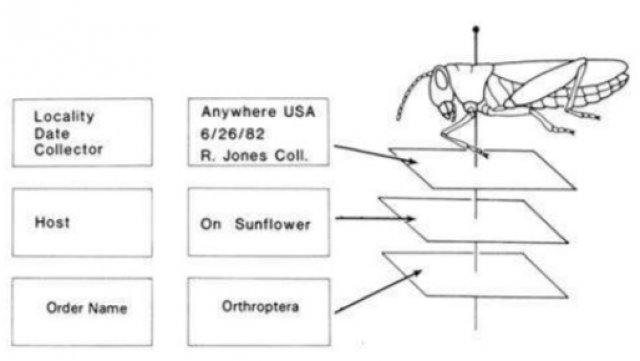
Insect Label Data
Collection (First) Label:
Locality:
Lincoln, NE
Date:
09/26/03
Collector: D. L. Keith, Coll.
The above label was reduced (below) to a font size of 6.
Second Label:
Order Name: Orthoptera
Family Name: Acrididae (10 specimens identified to family)
Organizing Your Insect Collection in Schmidt Boxes
Do not pin vials of insects in Schmidt boxes!
These often come loose, roll around and damage insect specimens. Keep your vials in a plastic bag with some tissue or styrofoam “popcorn” to cushion them and prevent breakage. Otherwise, use strong rubber bands to hold vials together. Place only neatly pinned and labeled specimens in collection boxes. Organize them into sections by taxonomic grouping (i.e. Order) and position and space all labels neatly on the pin, so that the specimens are arranged in neat rows. Place a large label below and in the center of each order group. Order labels should be about 2" long, 1/2" wide and neatly printed with black lettering. Neatness in pinning, mounting and displaying insects is important.










